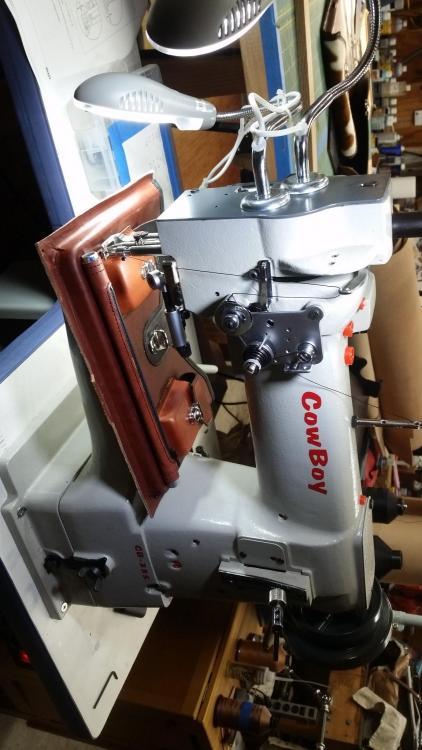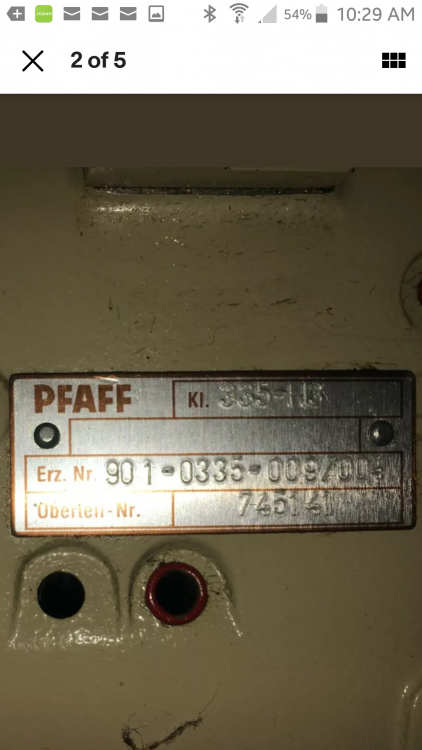
Silverd
Members-
Posts
489 -
Joined
-
Last visited
Content Type
Profiles
Forums
Events
Blogs
Gallery
Everything posted by Silverd
-
For sale. Cow Boy 335 leather stiching clinder arm in perfect condition with extra bobins, cases, needles, feed dogs and presser feet. Purchased new in December of 2019 and only used a couple of hours since. Works perfectly! Corona related job loss forces sale but my lose is your gain as they say. Head only. Will package and ship to anywhere within the continental USA. Bob Kovar supported through Tolledo industrial Sewing. Pacificleather2018@yahoo.Com Or call me directly for more information 805-701-3990 Don
- 9 replies
-
- barely used
- leather stitcher
-
(and 1 more)
Tagged with:
-
Consew 227 Vs. 277 And Their Various Models.
Silverd replied to overackerh's topic in Leather Sewing Machines
Wiz is the "Man" I can confirm Silverd -
If you are stuck on the Pfaff 335 size cylinder arm I would suggest you look at the Techsew 2600 Narrow. This clone version of the 1 7/8" diameter cylinder arm has true compound drop feed (the feed dog drops down between forward and backwards motion). The Pfaff 335s do not; they have a "scuff" dog that only oscillates back and forth. I own a Pfaff clone and although its a good machine, it lacks an important element of control of material feed. Pricing is competitive on this machine as well. Silverd
-
The CB-335 Cowboy clone I own is a good machine that I purchased for sewing small clutches and the like but is not my first go to for anything else. It is a bit light weight for a lot of work, has limited foot clearance, a short max stitch length and the scuffing style dog is not nearly as effective as an oscillating type. 50mm cylinder arm machines with drop feeds are very expensive (Juki DSC-245/246) and are rare so the buy in cost of 335s is low but It really is more of a specialty machine than a general purpose in my opinion. I do agree however, that if only one machine, a cylinder arm is a great choice. Uwe, makes after market flat bed attachments for many cylinder models and you might consider getting one. I think his tables are the best on the market and own two of them. The attachment gives you flat bed practicality with cylinder versatility for about a hundred bucks. Good luck! Silverd.
-
Love it...I'm thinking you got away easy making your belt for only $3k! Silverd
-
I've dyed thread inadvertently using black Fiebings Pro Dye with disastrous results. I only died the thread because I was attempting to recolor the leather where the needle had come through on the back side of the piece. The dye wicked up to the top side continued to bleed out of the thread, cross contaminating the piece and my hands several weeks after application. That's what I got for you! Silverd
-
It is. Are these models any better than the clones currently be sold by various suppliers do you know? I'm struggling to get consistent sewing performance from my 335 and am considering the purchase of this original pfaff. Silverd
-
Unable to post more photos in this string.
-
-
Can someone in the group make comment as to the age of this machine? Or any information based on the model number? Thank you! Silverd
-
Sounds like a tension gauge might help. The cost of these devices is low therefore risk is low should you not find suitable application. I'd be interested in hearing how it works out should you decide to proceed. Silverd
- 24 replies
-
- thread tension gauge.
- thread tensioner
-
(and 3 more)
Tagged with:
-
Wow I'm not alone as some would suggest. Great stuff this tension setting quest. I'm a beliver in science being a mechanical engineer and all. We have a tendency to put stock in measuring over trial and error methods of which there are a plenty of everyday as it is. Sure I can get to a ballanced stitch without anything but a screwdriver, but if there is a tool that can reduce set up time at any point in the process, count me in. Silverd Thank you BTW for the links on this topic.
- 24 replies
-
- thread tension gauge.
- thread tensioner
-
(and 3 more)
Tagged with:
-
I The sewing community collects more than one kind of iron... I'll let you know about the versatility if I proceed.
- 24 replies
-
- thread tension gauge.
- thread tensioner
-
(and 3 more)
Tagged with:
-
Your statement speaks to my original question. Has anyone experience actualy using a tension gauge? I've been sewing a few years on several machines and understand how to set tension using the trials method quite successfully. Introducing more tools to a process can mean more time. Introducing the right tools can save time. We advance skills, technology and capabilities by questioning the status quo then working toward better solutions. This topic is just another example. I appreciate your keep it simple approach. If the benefits don't out weight the added complexity then it certainly would be something I wouldnt use long term. But I'm curious. Apparently the only participate in this thread who has used a tension tool had good things to say about it, albeit in a different setting and application. Are you certain there is not a viable place in your tool box for such a device?
- 24 replies
-
- thread tension gauge.
- thread tensioner
-
(and 3 more)
Tagged with:
-
I am not advocating a direct relationship between leather weight and thread tension. Rather, using a gauge to help set the tension ratio between top and bottom when introducing a new thread. Then fine tune using the trials method. Silverd
- 24 replies
-
- thread tension gauge.
- thread tensioner
-
(and 3 more)
Tagged with:
-
My point exactly in that using a tool to measure a variable can serve to get a machine into its nominal setting value quickly. Please note that at no time do I make the argument that a tension gauge can replace the trials method for arriving at a final setting. There are too many other factors as you all indicate for that to be expected. I would think however that using a gauge in the process of establishing a nominal tension setting for top and bottom when loading a completely different thread for instance may be helpful. Or when returning a machine back to a previously established configuration....followed by a trial event to finalize. Rocky, have you ever used a thread tension measuring device in this way? Silverd
- 24 replies
-
- thread tension gauge.
- thread tensioner
-
(and 3 more)
Tagged with:
-
After a bit more consideration... I'm scratching my head about the general response above which appears to suggest that trial over measure is the best method for establishing system tension. Usually, science is at its best when accurate data is collected and applied. Good data relies on good measurement which in this case points to the use of a suitable tension gauge. In many systems experience can augment good science but in the case of establishing the ideal tension setting for a leather matrix, it appears to be the default solution within the sewing community. The experience, im refering to includes a combination of actual sewing experience along with the application of trials aka the sew-off. But how could the measurement and recording of tension data not be beneficial to our end goal? My personnel understanding of the influences that thread size, thread material and thread density have on setting the top and bottom tension is limited. Additionally, the system varables are numerous. Getting to the perfect solution is likely not possible using tension data alone, but getting within striking distance might be quickened by using a tension gauge to setup the host machine with an initial 2/3 tension rato then dialing in from there using the trial method. I suggest there should also be benefits from recording specific proven tension values when using specific thread, leather matrix and needle size. These set ups can be reproduced back to their nominal values very quickly and fine tuned from there using trials. I'd be interested in hearing more of the rational that supports soul reliance on trials as the solution to establishing ideal system settings. Silverd
- 24 replies
-
- thread tension gauge.
- thread tensioner
-
(and 3 more)
Tagged with:
-
I'm attempting to find ways to shorten the change over time. I have two machines set up for sewing 1mm HO bags that I periodically need to change over for other work. I already have dedicated bobbin holders for the bag thread I use and record the top thread tension adjustment and path for these set ups. I'm hoping that measuring the tension might expedite the change back process. Otherwise, yes,....I can get along using a trial and error method too as you suggest. Silverd
- 24 replies
-
- thread tension gauge.
- thread tensioner
-
(and 3 more)
Tagged with:
-
What bobbin type (L or M) does the 335 use? Silverd
-
Hello I'm considering the purchase of a Thread Tension Gauge. Does anyone have experience with these devices? Silverd
- 24 replies
-
- thread tension gauge.
- thread tensioner
-
(and 3 more)
Tagged with:
-
HaHaHa...More profitable!!! I can dream right? Seriously though I love the idea of making and repairing equestrian tack and saddles etc, but I've really struggled to break into the local community here in So. CA. I don't blame anyone but my own lack of basic horse knowledge and lack luster marketing. Done a few jobs that worked out nicely but more that were special one off equestrian prototype or development projects where clients wanted NDAs signed or special rigs for injured horses. One customer wanted me to do work for someone I was never going to meet or speak to for the benefit of asking questions about what they wanted. After delivery of the custom tack, I never received feed back as to if they were happy or not so I assume they were not since Ive not seen repeat or word of mouth follow-on business. Meanwhile I have quite a bit invested in the tack and saddle repair direction including a 441 and a Landis 16 that I have been rebuilding not to mention an impressive collection of hardware, big threads, splitters and appropriate hides. About the time I noticed a slow down in saddle work, I hooked up with an Artisan's store in Santa Barbara CA that wanted hand made leather things made by a local artist to sell; so I jumped on the offer and have since been very busy. This required a complete new set of equipment including a juki 1541S and a Pfaff 335 plus an impressive collection of light thread, light leathers, smaller tools, spray guns, glue dispenser, accessories and on and on. Commission is 50% but they stock, display, sell, collect and distribute me a check once a month. So, I'm still in the leather game with this gig and am expanding my products of wallets, clutch, hand bags, dog collars, cell phone cases, I-Pad Cases, Credit Card holders, and key chains products. The goal for me is to identify which products sell and for how much...I don't really need the $ but I really want to Crack the Code sort of speak while extending my leather working skill set. Now days I occasionally I will get a call for a zipper repair, or to make longer stirrup leathers and fenders or for a Saddle or chaps repair. I get help from Sharron at BigSiouxSaddlery for many of these projects. She has offered countless how-to tips and advised me as to what jobs to steer clear of and which ones to tackle. There is however a lot to know about the Horse and a strict set of rules that must be followed closely. Without that direct knowledge someone like myself probably has little chance of satisfying the demanding equestrian customer. Silverd
- 53 replies
-
- herman oak
- water proofing
-
(and 3 more)
Tagged with:
-
-
Vintage pfaff 335G-h3 stitching problems
Silverd replied to tibee's topic in Leather Sewing Machines
Is the 335 the only small diameter cylinder arm machine for leather available? Its intended for binding applications. is there a non binding version for instance? Silverd -
Swiss Army knife Cases
Silverd commented on AlexOstacchini's gallery image in Gallery- Our Leatherwork
-
Wow! Great information. I'll be attempting to make that adjustment as well in that case. Many thank Gentlemen! Silverd
- 3 replies
-
- 134-35 & 135 x 16
- pfaff 335
-
(and 1 more)
Tagged with:



